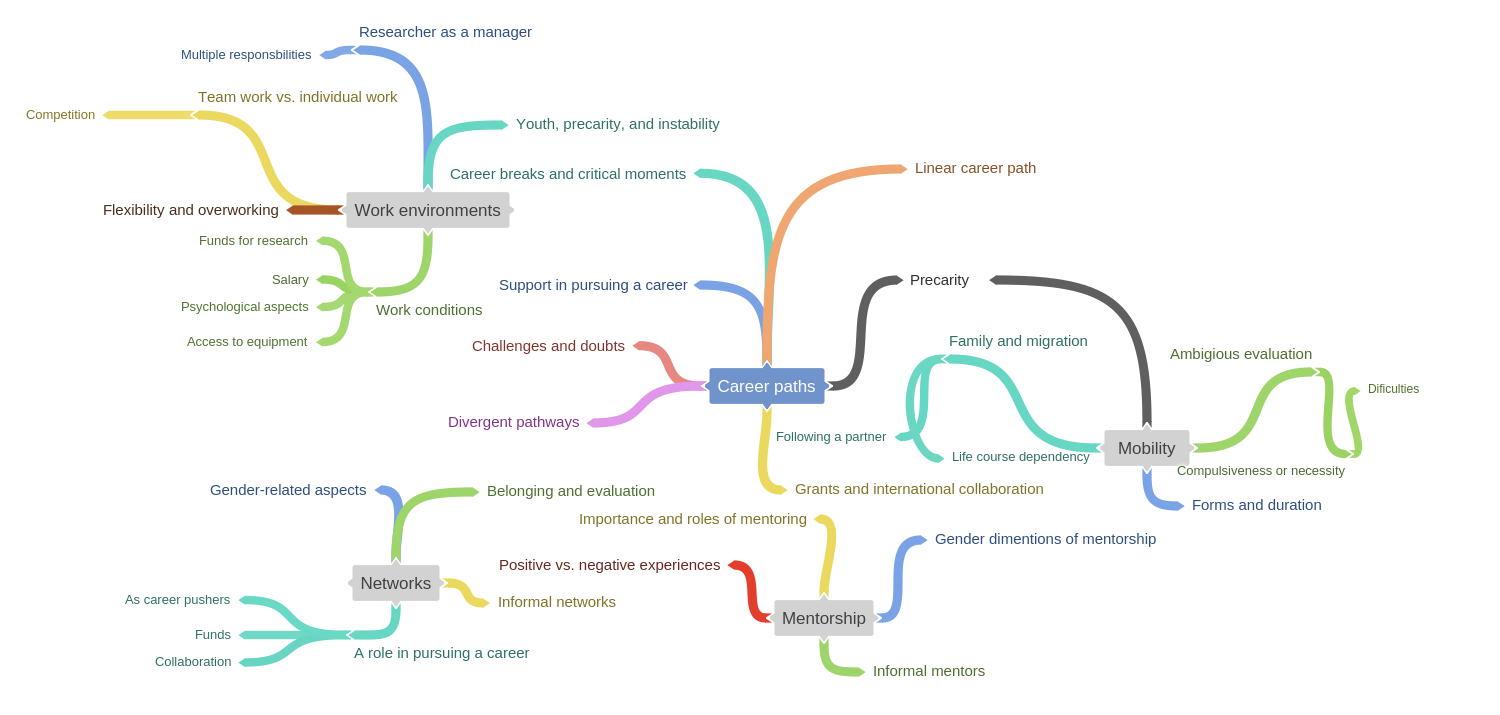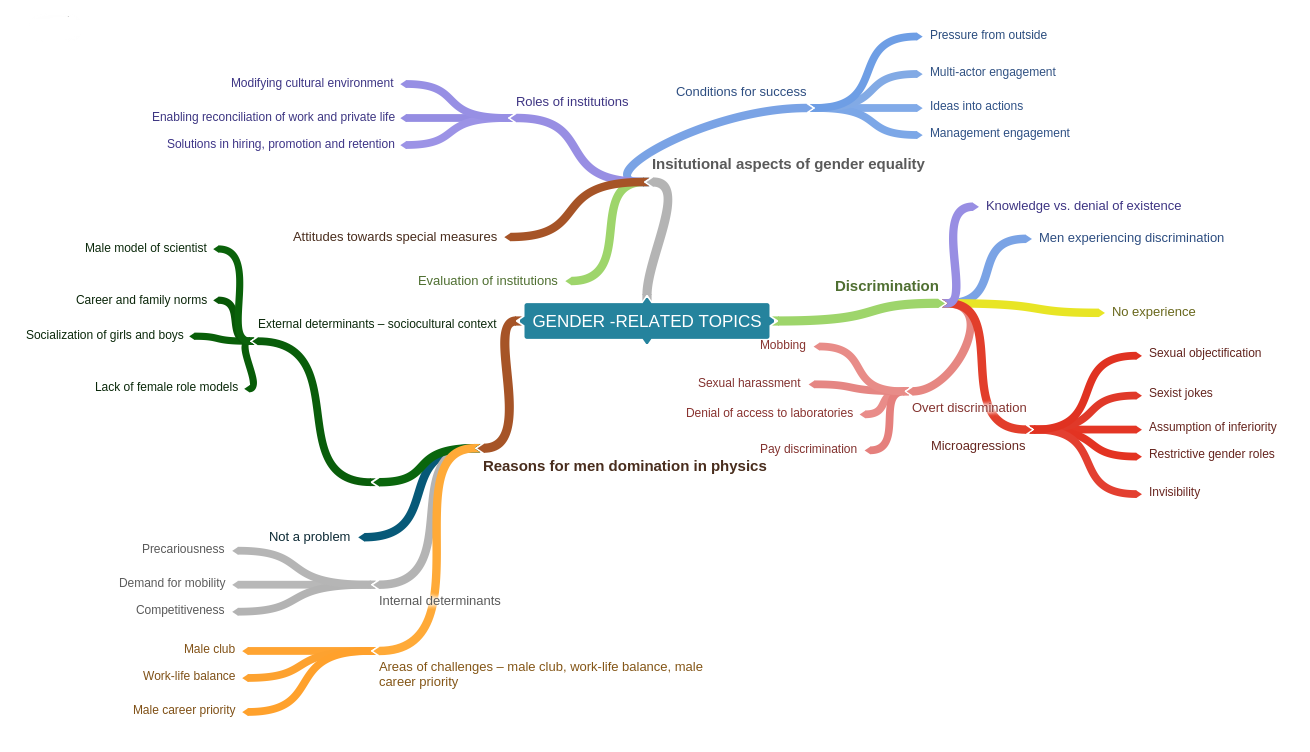Table of Contents
Outcome of the GENERA interview series
Introduction
In order to gather all necessary information for dealing with the problems discussed above two separate methods of interviewing have been applied. The first one - the semi-standardized interview - were introduced to the interviews carried out among physicists, both female and male. This method is based on an assumption that people in general as social actors construct their “subjective theories” about their life and experiences. The notion of “subjective theory” refers to the fact that “the interviewees have a complex stock of knowledge about the topic under study” (Flick 2006: 155). Some of the information could be delivered by the respondents in an explicit way, the other information (“implicit assumptions”) must be articulated with a support of methodological aids (e.g. several additional questions). A general rule is that in every sub-section of the interview the interviewer starts with an open question (usually very general) and then asks several following more detailed questions. With the use of semi-standardized interviews, the individual aspects of workaday life of physicists, perceived and experienced gender discrimination and strategies to overcome barriers to career development have been verified.
The second method - the expert interviews - was applied to the interviews with physicists occupying leading positions in their organizations (such positions usually meant rectors, deans, directors, project leaders, etc.). This technique is usually applied in the research with a very specific and restricted area of study. It helps to exclude from the interview all unproductive topics that may occur e.g. during the narrative interviews. The expert interview is therefore centred around a very specific topic and organized by a list of questions. The expert interviews were focused only on gender discrimination and measures for fostering gender equality.
The main aims of this qualitative research were to:
- analyze women's and men's career paths in physics, especially structural, political, organizational and cultural barriers to and factors that enhance their success;
- identify successful approaches and innovative ideas for gender equality measures in physics oriented research field and successful gender actions of institution and countries for strengthening women's careers in physics and leading to reaching better gender balance in their participation;
- define set of immediate implementation activities for all other partners and countries to be included in Toolbox and Gender Equality Plans.
The members of GENERA consortium conducted 83 interviews, including 67 semi-standardized interviews with physicists and 16 expert interviews with leaders of the researched institutions. To include various perspectives, experiences and standpoints the research sample for semi-standardized interviews was diversified to include both female and male physicists as well as researchers occupying various academic positions (from postdoctoral researchers and research assistants to full professors in physics) and specializing in many sub-disciplines of physics. Three interviews were conducted with physicists from emerging fields.
Table 1. Study sample
| Country | Physicists | Leaders (L) | TOTAL | ||||
|---|---|---|---|---|---|---|---|
| Female (F) | Male (M) | Female | Male | ||||
| Young (Y) | Senior (S) | Young | Senior | ||||
| Germany - 3 institutions | 7 | 2 | 1 | 1 | 4 | 3 | 18 |
| Netherlands | 1 | - | - | 1 | - | - | 2 |
| Italy - 2 institutions | 3 | 4 | 2 | 2 | - | 1 | 12 |
| Spain | 4 | 3 | 1 | 1 | - | - | 9 |
| Switzerland | 1 | 1 | - | 1 | 1 | 1 | 5 |
| Romania | 1 | 3 | 1 | 2 | 1 | 1 | 9 |
| France | 2 | 1 | 1 | 1 | 1 | - | 6 |
| Poland - 2 institutions | 5 | 7 | 2 | 5 | 1 | 2 | 22 |
| Total number of interviews | 24 | 20 | 8 | 14 | 8 | 8 | 83 |
The 12 institutions from 8 countries represented in the sample are research performing organizations, including both physics research institutes and physics departments of universities.
The inquiry was performed in 2016 and 2017. The partner institutions followed a research manual comprising semi-structured and expert interviews scenarios1). For each interview a structured note with exact citations from a narrative was prepared.
Challenges regarding the fieldwork
Although the data have been collected according to the research plan, several challenges related to gathering information and preparing structured notes for further analysis had to be responded to by the research team. First and foremost, in terms of the sample not every regional team managed to include physicists working in emerging subfields to the study. The national samples differed from each other with respect to: 1/ a number of conducted interviews (from 2 to 11), 2/ internal diversification of the interviewees when it comes to gender, age (young or senior researchers), position (being in a leading position). The structured notes used for the analysis are as well very diversified: while some of them were composed of long, narrative and informative citations from the interviews, the others presented only short citations and descriptions. Not all notes covered every topic addressed in the interview script.
Coding and analysis
In the study both open and theory-driven codes were applied. Codes in qualitative research are often defined as “a word or short phrase that symbolically assigns a summative, salient, essence-capturing” (Saldana 2010: 3). Open coding describes a process of reflective reading through collected data and creating tentative codes emerging from the materials. The codes are then integrated in more abstract and universal patterns. Theory-driven coding means using theories and research findings to create codes before actual coding of the material. In the context of GENERA inquiry, Report D2.2 on how to improve the research cultural environment has been used as such a theoretical base. In the analysis the JU team undertook the following steps with regards to coding:
- General categories (topics) on the basis of the literature review (Report D2.2 on how to improve the research cultural environment) have been used for the division of the materials into several thematic blocks, including career paths and their challenges, work conditions and environment, mobility, networks, mentorship, reasons for domination of men in physics, experiences of different treatment, and institutional aspects of gender equality;
- The structured notes (and transcripts from one institution) were uploaded to QDA Miner program and assigned to each region (a country). Basic variables (gender, research experience: young/senior, position: being in a leading position) were assigned to every uploaded document.
- Each researcher (four sociologists were involved in the analysis) applied open coding to the given materials.
- Finally, the codes were verified, ordered, and integrated in more general categories in order to avoid repetitions.
The trees of codes guiding the analysis are illustrated by the following pictures.







